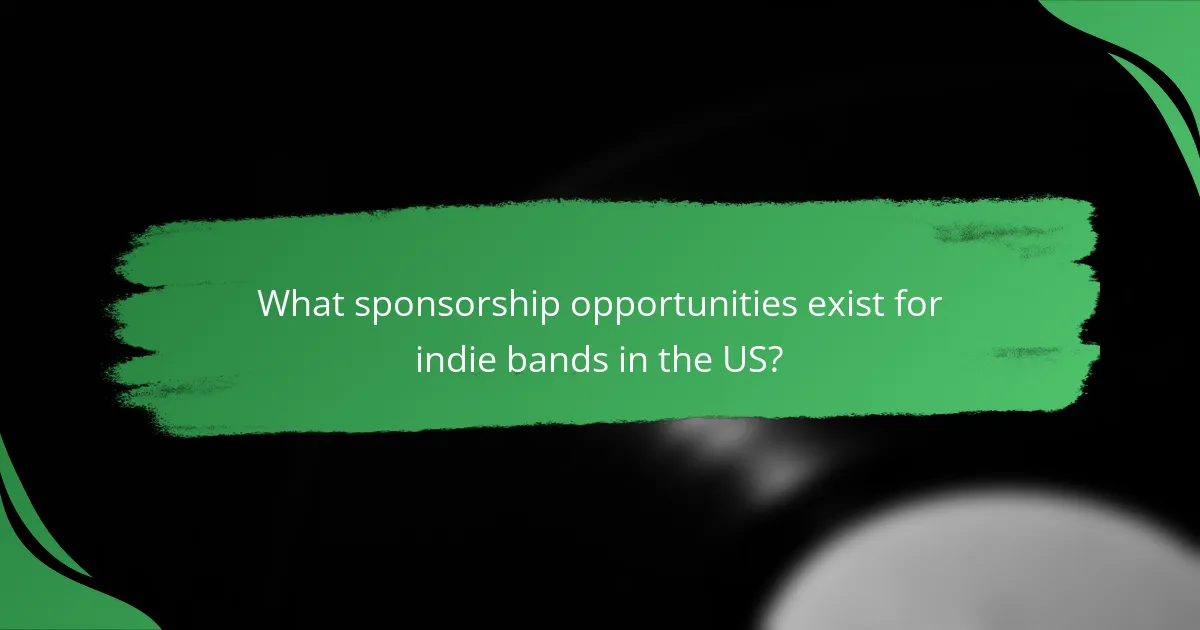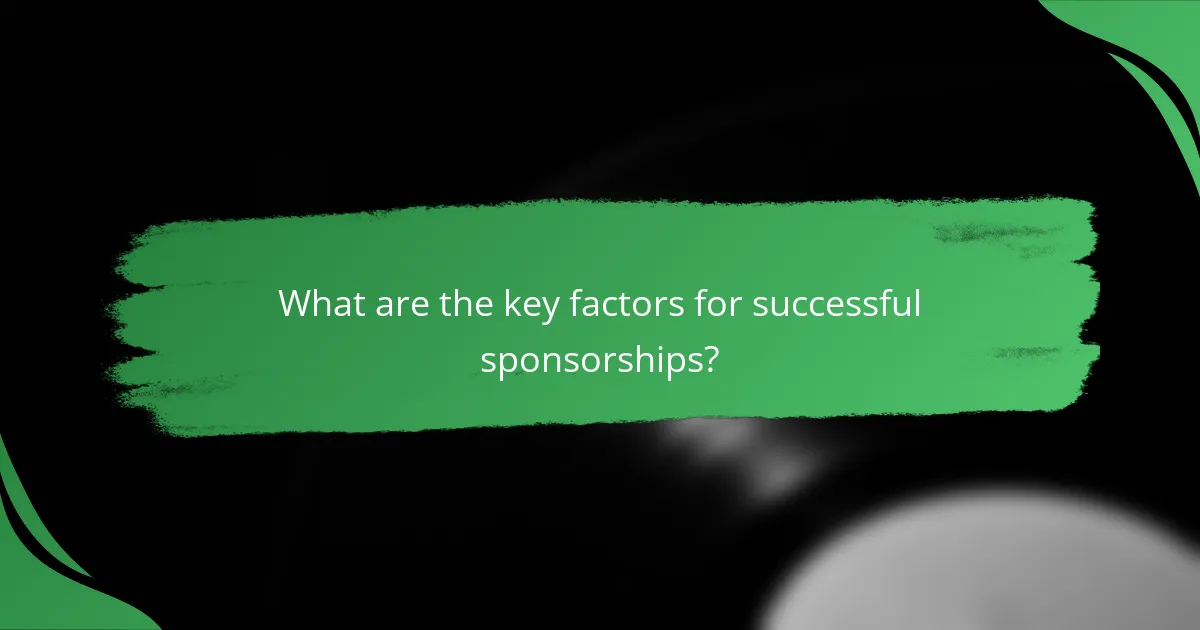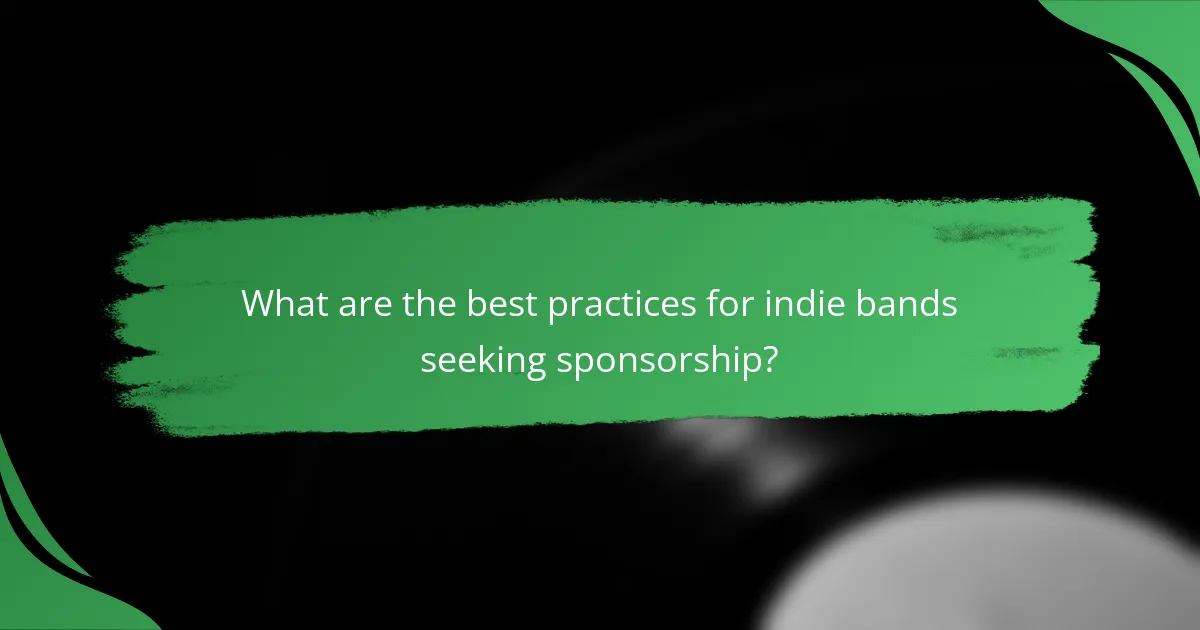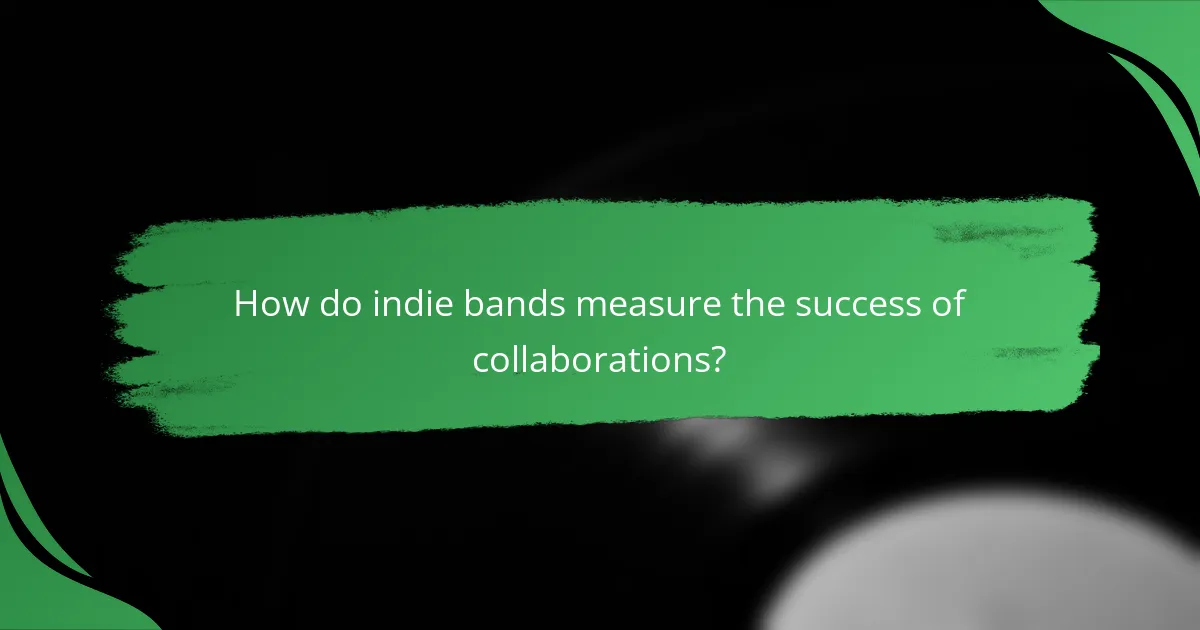Indie bands in the US have a wealth of sponsorship opportunities that can boost their visibility and provide essential financial support. By forming partnerships with local businesses, engaging in event sponsorships, and collaborating with streaming platforms, these artists can access new audiences and resources. Successful collaborations hinge on shared values and clear communication, paving the way for mutually beneficial relationships that enhance creativity and reach.

What sponsorship opportunities exist for indie bands in the US?
Indie bands in the US can explore various sponsorship opportunities to enhance their visibility and financial support. These include partnerships with local businesses, event sponsorships, collaborations with streaming platforms, merchandise sponsorships, and grants from arts organizations.
Brand partnerships with local businesses
Indie bands can form partnerships with local businesses to mutually benefit from increased exposure. For example, a band might perform at a local café in exchange for promotional support, such as featuring the band’s logo on marketing materials.
When approaching local businesses, focus on how the partnership can enhance their brand visibility. Offering to promote the business on social media or during performances can create a win-win scenario.
Music festivals and event sponsorships
Participating in music festivals can provide indie bands with significant sponsorship opportunities. Festivals often seek to partner with bands for promotional purposes, offering exposure to larger audiences in exchange for brand visibility.
Indie bands should research festivals that align with their music style and audience. Applying early and showcasing a strong online presence can improve chances of securing sponsorships or performance slots.
Collaborations with music streaming platforms
Music streaming platforms frequently look to collaborate with indie bands to promote new music. These collaborations can include playlist placements, featured artist spots, or promotional campaigns that highlight the band’s work.
Indie bands should reach out to streaming services with a clear pitch that outlines their unique sound and audience engagement. Building a solid online following can make these collaborations more appealing to platforms.
Merchandise sponsorships
Merchandise sponsorships allow indie bands to partner with brands that provide products for sale at concerts or online. This can include clothing, accessories, or music-related items that resonate with the band’s image.
To secure merchandise sponsorships, bands should identify brands that align with their values and audience. Offering to feature the brand’s logo on merchandise can create additional promotional opportunities.
Grants from arts organizations
Many arts organizations in the US offer grants specifically for indie bands to support their projects and performances. These grants can provide financial assistance for recording, touring, or promotional activities.
Indie bands should research available grants and ensure they meet eligibility criteria. Preparing a compelling application that outlines the project’s impact and budget can increase the chances of receiving funding.

How can indie bands benefit from collaborations?
Indie bands can significantly enhance their visibility and resources through collaborations. By partnering with other artists, brands, or organizations, they can tap into new audiences, gain access to funding, and explore innovative creative avenues.
Increased exposure and audience reach
Collaborating with other musicians or brands allows indie bands to reach wider audiences. For example, a joint concert or a shared social media campaign can introduce each band’s fan base to the other, potentially increasing followers and listeners.
Utilizing platforms like Spotify or YouTube for collaborative tracks can also boost streaming numbers. When two or more artists promote a single project, they can leverage each other’s networks, leading to a greater cumulative reach.
Access to new resources and funding
Partnerships can provide indie bands with access to essential resources, including financial support. Collaborating with brands for sponsorships can lead to funding opportunities that cover recording costs, marketing, and touring expenses.
Additionally, working with established artists or organizations may offer access to professional studios, instruments, or promotional tools that would otherwise be unaffordable. This can significantly enhance the quality of their music and marketing efforts.
Enhanced creative opportunities
Collaborations can spark new ideas and creative directions for indie bands. Working with different artists can lead to unique sounds and styles, pushing bands to experiment beyond their usual genres.
For instance, a band might collaborate with a visual artist for a music video, integrating visual storytelling with their music. Such creative partnerships can result in innovative projects that stand out in a crowded market.
Networking with industry professionals
Collaborating often opens doors to valuable networking opportunities. Indie bands can connect with producers, managers, and other industry professionals through their partners, which can lead to further collaborations or career advancements.
Attending joint events or festivals can also provide exposure to key players in the music industry. Building these relationships is crucial for long-term success and can lead to more significant opportunities down the line.

What are the key factors for successful sponsorships?
Successful sponsorships hinge on several key factors that foster mutually beneficial relationships between indie bands and brands. These include alignment of brand values, compatibility of target audiences, and clear communication of goals.
Alignment of brand values
For a sponsorship to thrive, the values of the indie band must resonate with those of the sponsoring brand. This alignment creates authenticity, which is crucial for engaging fans and consumers alike. For example, a band that promotes sustainability should partner with eco-friendly brands to enhance credibility.
When evaluating potential sponsors, consider how their mission and vision align with your band’s ethos. A mismatch can lead to backlash from fans and dilute the brand’s message.
Target audience compatibility
Understanding the demographics and preferences of both the band’s and the brand’s audiences is essential. Successful partnerships often occur when both parties share a similar target market, ensuring that promotional efforts reach the right people. For instance, a band with a young, urban fanbase may benefit from collaborating with a trendy apparel brand that targets the same demographic.
Conducting audience research can help identify overlaps and enhance the effectiveness of marketing campaigns. Utilize social media analytics and surveys to gather insights about your audience’s interests and behaviors.
Clear communication of goals
Establishing clear objectives from the outset is vital for any sponsorship agreement. Both the band and the sponsor should articulate their goals, such as brand awareness, sales targets, or community engagement. This clarity helps in measuring success and adjusting strategies as needed.
Regular check-ins and updates can facilitate ongoing communication, ensuring that both parties remain aligned throughout the partnership. Consider creating a simple agreement that outlines expectations, deliverables, and timelines to avoid misunderstandings.

What are the best practices for indie bands seeking sponsorship?
Indie bands can effectively seek sponsorship by focusing on a few key practices that enhance their appeal to potential sponsors. These include crafting a compelling pitch, establishing a robust online presence, and developing a clear sponsorship proposal template.
Developing a compelling pitch
A compelling pitch is essential for grabbing the attention of potential sponsors. Start by clearly defining your band’s unique value proposition, such as your music style, audience demographics, and any previous successes. Tailor your pitch to align with the sponsor’s brand values and marketing goals.
Include specific examples of how the partnership can benefit the sponsor, such as exposure at events, social media mentions, or product placements. Keep the pitch concise and engaging, ideally no longer than one page, to maintain interest.
Building a strong online presence
Having a strong online presence is crucial for indie bands looking to attract sponsorship. Utilize social media platforms like Instagram, Facebook, and TikTok to showcase your music, engage with fans, and highlight any past collaborations or performances. Regularly update your content to keep followers engaged and attract new listeners.
Consider creating a professional website that includes your music, tour dates, press kit, and contact information for potential sponsors. This central hub can serve as a valuable resource for brands looking to understand your band and its audience.
Creating a sponsorship proposal template
A well-structured sponsorship proposal template can streamline the process of securing partnerships. Start with an introduction that outlines your band’s mission and vision, followed by a section detailing the sponsorship opportunities available, such as event sponsorship, merchandise collaborations, or social media campaigns.
Include a breakdown of the benefits for the sponsor, such as brand visibility and audience engagement metrics. Finally, provide clear terms and conditions, including sponsorship levels and associated costs, to facilitate decision-making for potential sponsors.

How do indie bands measure the success of collaborations?
Indie bands measure the success of collaborations through various metrics that reflect audience engagement, financial performance, and sponsor feedback. These indicators help bands understand the impact of their partnerships and refine future strategies.
Tracking audience engagement metrics
Audience engagement metrics are crucial for indie bands to evaluate the effectiveness of collaborations. Key indicators include social media interactions, streaming numbers, and attendance at events. For example, a spike in social media mentions or shares can indicate increased interest stemming from a collaboration.
To effectively track these metrics, bands can use analytics tools provided by platforms like Spotify, Instagram, and Facebook. Setting specific goals, such as a target number of new followers or streams, can help in assessing the success of each collaboration.
Analyzing sales and revenue growth
Sales and revenue growth are direct indicators of a collaboration’s financial success. Indie bands should monitor merchandise sales, ticket sales, and streaming revenue before and after collaborations to gauge impact. A notable increase in these areas often signals a successful partnership.
For instance, if a band collaborates with a popular brand and sees a 20-30% increase in merchandise sales, it suggests that the collaboration resonated well with fans. Regularly reviewing financial statements can help bands identify trends and adjust their strategies accordingly.
Gathering feedback from sponsors
Feedback from sponsors is essential for understanding the perceived value of a collaboration. Indie bands should actively seek input from sponsors regarding their experience and the outcomes of the partnership. This can be done through surveys or informal discussions post-collaboration.
Effective feedback can highlight what worked well and what could be improved. For example, if a sponsor notes that their brand visibility increased significantly during a tour, it indicates a successful collaboration. Bands should use this information to strengthen future partnerships and align better with sponsor expectations.


